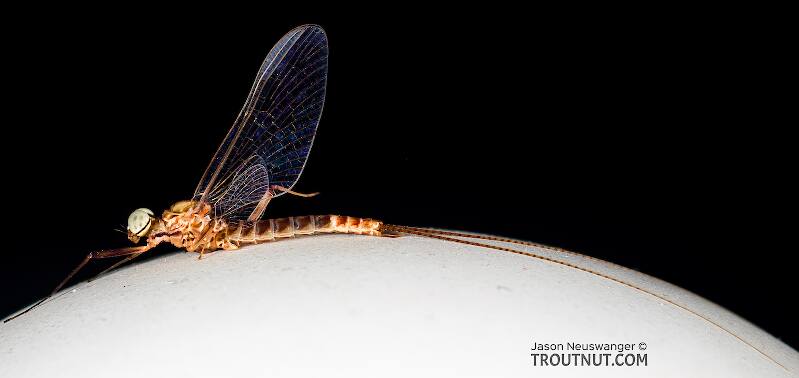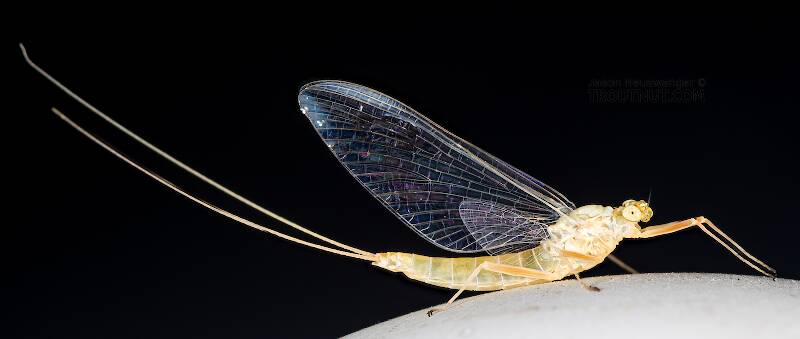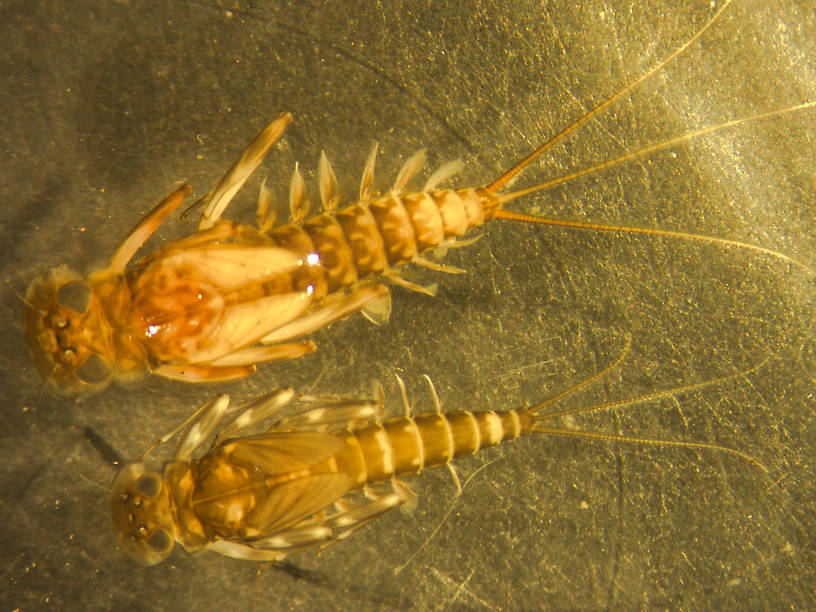
Salmonflies
Pteronarcys californica
The giant Salmonflies of the Western mountains are legendary for their proclivity to elicit consistent dry-fly action and ferocious strikes.
Featured on the forum

This one was surprisingly straightforward to identify. The lack of a sclerite at the base of the lateral hump narrows the field quite a bit, and the other options followed fairly obvious characteristics to Clostoeca, which only has one species, Clostoeca disjuncta.

Troutnut is a project started in 2003 by salmonid ecologist Jason "Troutnut" Neuswanger to help anglers and
fly tyers unabashedly embrace the entomological side of the sport. Learn more about Troutnut or
support the project for an enhanced experience here.
Mayfly Genus Ecdyonurus (Western Ginger Quills)
This fairly new genus holds some Western species that used to be in Nixe and were in Heptagenia before that. They are mentioned in books by those generic names. Ecdyonurus simpliciodes is especially important.
Where & when
In 39 records from GBIF, adults of this genus have mostly been collected during September (28%), July (28%), August (18%), October (10%), and June (10%).
In 33 records from GBIF, this genus has been collected at elevations ranging from 1450 to 9318 ft, with an average (median) of 5489 ft.
Genus Range
Hatching behavior
These species hatch in or near the surface in calm water. Emergence is quite fast, but the duns may drift a while.Spinner behavior
Time of day: Dusk
Habitat: Riffles
Specimens of the Mayfly Genus Ecdyonurus
1 Male Spinner

This one was very puzzling to identify. It's clearly Heptageniidae. It keys pretty easily to couplet 58 in Merritt, Cummins, & Berg 5th Edition, but that's where things get tricky.
58: Male penes distinctly L-shaped; Segment 1 of foretarsi usually 1/3 to 2/3 the length of segment 2
58': Males penes not distinctly L-shaped; Segment 1 of foretarsi usually 1/5 to 1/2 the length of segment 2
The characteristics conflict here, as I'd say the penes ARE L-shaped, but the fore tarsal ratio is less than 1/3. Maybe the weasel word "usually" allows for that, and it's some kind of Stenonema, for which I'm not aware of any records in Montana, let alone western Montana.
Going by the tarsal ratio and assuming it's not Stenonema, everything in couplet 60 points to Afghanurus: contiguous compound eyes, genitalia similar to fig 13.222 in MC&B, and weakly developed basal costal crossveins in the forewings. But I looked up the original descriptions of the three Afghanurus species, and the body sizes (flowersi 5-7 mm, inconspicua 4 mm, joernensis 6-7 mm) are way below this one's 10 mm.
This led me to notice that the closely related Ecdyonurus is not included in the key at all, so I checked the descriptions of those species and found that Ecdyonurus criddlei fits very well: the color of the legs, the markings on the tergites and sternites, the short fore tarsus and ratios of the segments, etc. It was originally described as 7 mm, smaller than the 10 mm body of this specimen, but synonyms have been described with larger sizes including wing lengths up to 11 mm for females for Heptagenia salvini.
This specimen was found with a female nearby, which I think is probably the same species, although it is difficult to be certain.
58: Male penes distinctly L-shaped; Segment 1 of foretarsi usually 1/3 to 2/3 the length of segment 2
58': Males penes not distinctly L-shaped; Segment 1 of foretarsi usually 1/5 to 1/2 the length of segment 2
The characteristics conflict here, as I'd say the penes ARE L-shaped, but the fore tarsal ratio is less than 1/3. Maybe the weasel word "usually" allows for that, and it's some kind of Stenonema, for which I'm not aware of any records in Montana, let alone western Montana.
Going by the tarsal ratio and assuming it's not Stenonema, everything in couplet 60 points to Afghanurus: contiguous compound eyes, genitalia similar to fig 13.222 in MC&B, and weakly developed basal costal crossveins in the forewings. But I looked up the original descriptions of the three Afghanurus species, and the body sizes (flowersi 5-7 mm, inconspicua 4 mm, joernensis 6-7 mm) are way below this one's 10 mm.
This led me to notice that the closely related Ecdyonurus is not included in the key at all, so I checked the descriptions of those species and found that Ecdyonurus criddlei fits very well: the color of the legs, the markings on the tergites and sternites, the short fore tarsus and ratios of the segments, etc. It was originally described as 7 mm, smaller than the 10 mm body of this specimen, but synonyms have been described with larger sizes including wing lengths up to 11 mm for females for Heptagenia salvini.
This specimen was found with a female nearby, which I think is probably the same species, although it is difficult to be certain.
1 Female Spinner

This one was collected close to a male which, based on size and general structure, was likely the same species. Females are supposed to be lighter-colored and with less distinct markings than the males, although the difference in this pair is particularly stark.
1 Nymph

This is an interesting Heptageniid mayfly since in western Montana it is only found in cold lakes, especially those in Glacier National Park.
Start a Discussion of Ecdyonurus
References
- Arbona, Fred Jr. 1989. Mayflies, the Angler, and the Trout. Nick Lyons Books.
- Caucci, Al and Nastasi, Bob. 2004. Hatches II. The Lyons Press.
- Knopp, Malcolm and Robert Cormier. 1997. Mayflies: An Angler's Study of Trout Water Ephemeroptera . The Lyons Press.
Mayfly Genus Ecdyonurus (Western Ginger Quills)
Taxonomy
Species in Ecdyonurus
Ecdyonurus criddleiLittle Slate-Winged Duns
3
19
Ecdyonurus simplicioidesWestern Ginger Quills
0
0
Species in Ecdyonurus: Ecdyonurus criddlei, Ecdyonurus simplicioides
1 species (Ecdyonurus bellus) isn't included.

